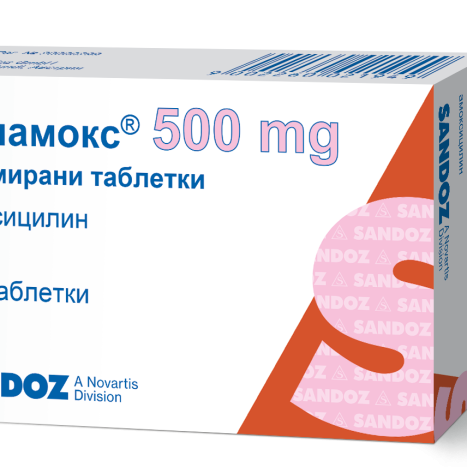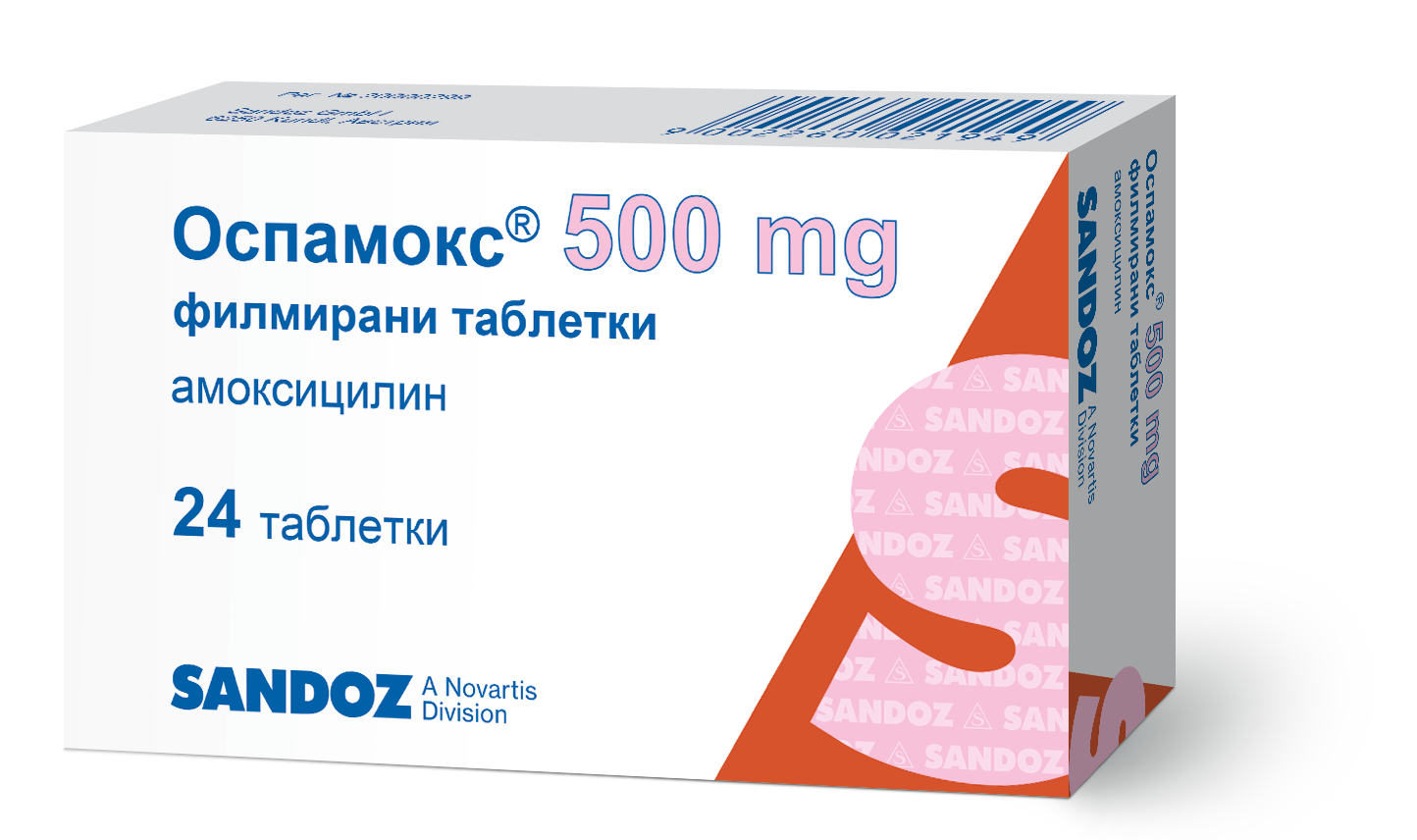OSPAMOX 500 mg x 24 tabl
Patient information leaflet
Ospamox 500 mg film-coated tablets
Ospamox 500 mg film-coated tablets
Ospamox 1000 mg film-coated tablets
Ospamox 1000 mg film-coated tablets
amoxicillin ( a moxicillin )
Read all of this leaflet carefully before you start taking this medicine because it contains important information for you .
- Keep this leaflet. You may need to read it again.
- If you have any further questions, ask your doctor or pharmacist.
- This medicine has been prescribed for you (or your child) personally. Do not pass it on to others. It may harm them, even if their signs of illness are the same as yours.
- If you get any side effects, tell your doctor or pharmacist. This includes any possible side effects not listed in this leaflet. See section 4.
What this leaflet contains
1. What Ospamox is and what it is used for
2. What you need to know before you take Ospamox
3. How to take Ospamox
4. Possible side effects
5. How to store Ospamox
6. Contents of the pack and other information
1. What O spamox is and what it is used for
What is Ospamox?
Ospamox is an antibiotic. The active substance is amoxicillin. It belongs to a group of medicines called "penicillins".
What is Ospamox used for?
Ospamox is used to treat infections caused by bacteria in various parts of the body. Ospamox can also be used in combination with other medicines to treat stomach ulcers.
2. What you need to know before you take Ospamox
Do not take Ospamox
- if you are allergic to amoxicillin, penicillin or any of the other ingredients of this medicine (listed in section 6).
- if you have had a severe allergic reaction to any other antibiotic. This may include a skin rash or swelling of the face or throat.
Do not take Ospamox if any of the above apply to you. If you are not sure, talk to your doctor or pharmacist before taking Ospamox.
Warnings and precautions
Talk to your doctor or pharmacist before taking Ospamox if you:
- you have glandular fever (high fever, sore throat, swollen lymph nodes and severe fatigue)
- you have kidney problems
- you are not urinating regularly.
If you are not sure if any of the above applies to you, talk to your doctor or pharmacist before taking Ospamox.
Blood or urine tests
If they do to you:
- Urine tests (urine glucose tests) or blood tests to monitor liver function
- Estriol tests (used during pregnancy to check if the baby is developing normally)
Tell your doctor or pharmacist that you are taking Ospamox. This is because Ospamox may affect the results of these tests.
Other medicines and Ospamox
Tell your doctor or pharmacist if you are taking, have recently taken or might take any other medicines.
- If you take allopurinol (used to treat gout) with Ospamox, you may be more likely to get an allergic skin reaction.
- If you are taking probenecid (used to treat gout), your doctor may decide to adjust your dose of Ospamox.
- If you are taking medications that prevent blood clots (such as warfarin), you may need to have additional blood tests.
- If you are taking other antibiotics (such as tetracycline) Ospamox may be less effective.
- If you are taking methotrexate (a medicine used to treat cancer and severe psoriasis). Ospamox may lead to an increase in side effects.
Pregnancy and breastfeeding
If you are pregnant or breast-feeding, think you may be pregnant or are planning to become pregnant, ask your doctor or pharmacist for advice before using this medicine.
Driving and using machines
Ospamox may cause side effects and symptoms (such as allergic reactions, dizziness and seizures) that may make you unable to drive.
Do not drive or operate machinery if you are not feeling well.
3. How to take O spamox
Always take this medicine exactly as your doctor or pharmacist has told you. If you are not sure, ask your doctor or pharmacist.
- Take the tablets with water without chewing.
- Divide doses evenly throughout the day, at intervals of at least 4 hours.
The usual dose is:
Children weighing less than 40 kg
All doses are determined depending on the child's body weight in kilograms.
- Your doctor will advise you on how much Ospamox you should give to your baby or child.
- The usual dose is 40 mg to 90 mg for each kilogram of body weight per day, divided into two or three separate doses.
- The maximum recommended dose is 100 mg for each kilogram of body weight per day.
Adults, elderly patients and children weighing 40 kg or more
The usual dose of Ospamox is 250 mg to 500 mg, three times a day or 750 mg to 1 g every 12 hours, depending on the severity and type of infection.
- Severe infections: 750 mg to 1g, three times daily
- Urinary tract infections: 3 g, twice daily for 1 day
- Lyme disease (an infection spread by parasites called ticks): Isolated erythema migrans (early stage - red or pink spherical rash): 4 g daily; Systemic manifestations (late stage for more serious symptoms or when the disease spreads throughout the body): up to 6 g daily.
- Stomach ulcer: one dose of 750 mg or 1g, twice daily for 7 days, with other antibiotics and medications to treat stomach ulcers.
- To prevent heart infection during surgery: the dose may vary depending on the type of surgery. Other medicines may be given at the same time. Your doctor, pharmacist or nurse can give you further information.
- The maximum recommended daily dose is 6 g per day.
Kidney problems
If you have kidney problems, the dose may be lower than usual.
If you take more Ospamox than you should
If you take more Ospamox than you should, signs may include stomach problems (nausea, vomiting or diarrhoea) or crystals in the urine, which may appear as cloudy urine or problems passing urine. Contact your doctor as soon as possible. Take the medicine to show the doctor.
If you forget to take Ospamox
- If you miss a dose, take it as soon as you remember.
- Do not take the next dose too soon, wait about 4 hours before taking it.
- Do not take a double dose to make up for a missed dose.
How long should you take Ospamox?
- Continue to take Ospamox for as long as your doctor tells you, even if you feel better. You need every dose to fight the infection. If some bacteria survive, they may cause the infection to come back.
- If you still do not feel well after your treatment is finished, you should see your doctor again.
Candidiasis (a fungal infection of moist areas of the body that can cause inflammation, itching and white discharge) may develop if Ospamox is taken for a long time. If this happens, tell your doctor.
If you take Ospamox for a long time, your doctor may order additional tests to check whether your kidneys and liver are working properly and whether your blood counts are normal.
If you have any further questions on the use of this medicine, ask your doctor or pharmacist.
This medicine contains less than 1 mmol sodium (23 mg) (main ingredient of cooking/table salt) per tablet, i.e. it can be said to be practically sodium-free.
4. Possible side effects
Like all medicines, this medicine can cause side effects, although not everybody gets them.
Stop taking Ospamox and see a doctor immediately if you notice any of the following serious side effects - you may need urgent medical treatment:
The following reactions are very rare (may affect up to 1 in 10,000 people):
- allergic reactions, signs may include: itching of the skin or rash, swelling of the face, lips, tongue, body or difficulty breathing. These can be serious and sometimes fatal
- rash or small flat red circular spots under the skin or bruising of the skin. This is due to inflammation of the blood vessel walls due to an allergic reaction. It may be associated with joint pain (arthritis) and kidney problems
- A delayed allergic reaction may occur, usually 7 to 12 days after taking Ospamox, some of the signs include: rashes, high fever, joint pain and enlarged lymph nodes, especially in the armpits.
- a skin reaction known as “erythema multiforme” where you may develop: itchy reddish-purple patches on the skin, especially on the palms of the hands or soles of the feet, “hive-like” raised swollen areas on the skin, painful areas on the surface of the mouth, eyes and genitals. You may have a high temperature and feel very tired
- other severe skin reactions may include: skin discoloration, lumps under the skin, blistering, blisters with pus, peeling, redness, pain, itching, scaling. May be associated with fever, headache, and body aches
- flu-like symptoms with rash, fever, swollen glands and blood test results that are outside the reference range (including increased levels of white blood cells (eosinophilia) and liver enzymes) (Drug Reaction with Eosinophilia and Systemic Symptoms (DRESS)).
- high fever, chills, sore throat or other signs of infection, or easy bruising. These may be signs of a problem with your blood cells
- the Jarisch-Herxheimer reaction , which develops during treatment with Ospamox for Lyme disease and causes high fever, chills, headache, muscle pain and skin rash
- inflammation of the colon, accompanied by diarrhea (sometimes containing blood), pain and high fever
- Serious side effects affecting the liver may occur. They have been observed mainly in people who have been treated for a long time, in men and in the elderly. You should tell your doctor immediately if you experience:
o severe diarrhea with bleeding
o blistering, redness or bruising of the skin
o darker urine or pale stools
o yellowing of the skin or whites of the eyes (jaundice). See also anemia below, which can lead to jaundice.
These reactions may occur while you are taking the medicine or up to a few weeks after you stop taking it.
If you experience any of the above reactions, stop taking the medicine and contact your doctor immediately.
Sometimes you may experience less severe skin reactions such as:
- mildly itchy rash (round, pink-red spots), “hive-like” swollen areas on the elbows, legs, palms, arms or feet. This reaction is uncommon (may affect up to 1 in 100 people).
Contact your doctor if you experience any of these reactions, as you will need to stop treatment with Ospamox.
Other possible side effects are:
Common (may affect up to 1 in 10 people)
- skin rash
- nausea
- diarrhea.
Uncommon (may affect up to 1 in 100 people)
- vomiting.
Very rare (may affect up to 1 in 10,000 people)
- candidiasis (a fungal infection of the vagina, mouth or skin folds). Your doctor or pharmacist may prescribe treatment for candidiasis
- kidney problems
- seizures (convulsions), seen in patients taking high doses or in patients with kidney problems
- dizziness
- hyperactivity
- crystals in the urine, which may appear as cloudy urine, or difficulty or discomfort when urinating. Make sure you drink enough fluids to reduce the chance of these symptoms occurring
- the color of the tongue may change to yellow, brown, or black and may appear “hairy”
- excessive destruction of red blood cells, causing a type of anemia. Signs include: tiredness, headache, shortness of breath, dizziness, paleness and yellowing of the skin and whites of the eyes
- decrease in white blood cells
- decrease in the number of cells involved in blood clotting
- It may take longer than usual for your blood to clot. You may notice this if you have a nosebleed or cut yourself.
Not known (frequency cannot be estimated from the available data)
- aseptic meningitis
Reporting side effects
If you get any side effects, tell your doctor or pharmacist. This includes any possible side effects not listed in this leaflet. You can also report side effects directly via the national reporting system to the Bulgarian Medicines Agency, 8 Damyan Gruev Str., 1303 Sofia, tel.: +35928903417, website: www.bda.bg. By reporting side effects, you can help to obtain more information on the safety of this medicine.
5. How to store O spamox
Keep out of the reach of children.
Do not use this medicine after the expiry date which is stated on the carton. The expiry date refers to the last day of that month.
Store below 25°C.
Store in the original package in order to protect from moisture.
Do not use this medicine if you notice any visible signs of product deterioration.
Do not throw away any medicines via wastewater or household waste. Ask your pharmacist how to dispose of medicines you no longer use. This will help to protect the environment.
6. Contents of the pack and other information
What Ospamox contains
The active substance is: amoxicillin (as trihydrate).
Ospamox 500 mg film-coated tablets
Each film-coated tablet contains 574 mg of amoxicillin trihydrate, which corresponds to 500 mg of amoxicillin.
Ospamox 1000 mg film-coated tablets
Each film-coated tablet contains 1148 mg of amoxicillin trihydrate, which corresponds to 1000 mg of amoxicillin.
The other ingredients are:
Core: magnesium stearate, polyvidone, sodium starch glycolate (Type A), microcrystalline cellulose;
Film coating: titanium dioxide, talc, hypromellose.
What Ospamox looks like and contents of the pack
Ospamox 500 mg film-coated tablets
The film-coated tablets are white to pale yellow, oval, biconvex, with a breakline on each side.
The film-coated tablets are packaged in blisters.
Packaging types: 12 film-coated tablets, 24 film-coated tablets and hospital packs of 1,000 film-coated tablets.
Ospamox 1000 mg film-coated tablets
The film-coated tablets are white to pale yellow, oval, biconvex, with a breakline on each side.
The tablet can be divided into two equal halves.
The film-coated tablets are packaged in blisters.
Packaging types: 12 film-coated tablets, 24 film-coated tablets and hospital packs of 1,000 film-coated tablets.
Not all types of packaging can be released for sale.
Marketing Authorisation Holder
Sandoz GmbH, 6250 Kundl, Austria
Manufacturer
Sandoz GmbH, 10 Biochemiestrasse,
6250 Kundl, Austria
Date the leaflet was last revised
09/2020
Basic recommendations regarding the use of antibiotics
Antibiotics are designed to treat infections caused by bacteria. They have no effect against infections caused by viruses.
Sometimes an infection caused by bacteria does not respond to antibiotic treatment. One of the most common reasons for this is that the bacteria causing the infection are resistant to the antibiotic used to treat it. This means that despite taking the antibiotic, they survive and even multiply.
Bacteria can become resistant to antibiotics for many reasons. Careful use of antibiotics can help reduce the chance of bacteria becoming resistant to them.
When your doctor prescribes a course of antibiotics, it is only intended to treat your current illness. Pay attention to the following recommendations and this will help prevent the emergence of resistant bacteria that can stop the antibiotic from working.
1. It is very important to take the correct dose of the antibiotic at the exact time and for the specified number of days. Read the instructions in the leaflet and if you need advice, contact your doctor or pharmacist.
2. Do not take an antibiotic unless it is prescribed for you. Use it only to treat the infection for which it was prescribed.
3. Do not take an antibiotic prescribed for another person, even if they have an infection similar to yours.
4. Do not give the antibiotic prescribed to you to other people.
5. If you have any unused antibiotic left after completing the course of treatment as prescribed by your doctor, return it to the pharmacy to be properly disposed of.








